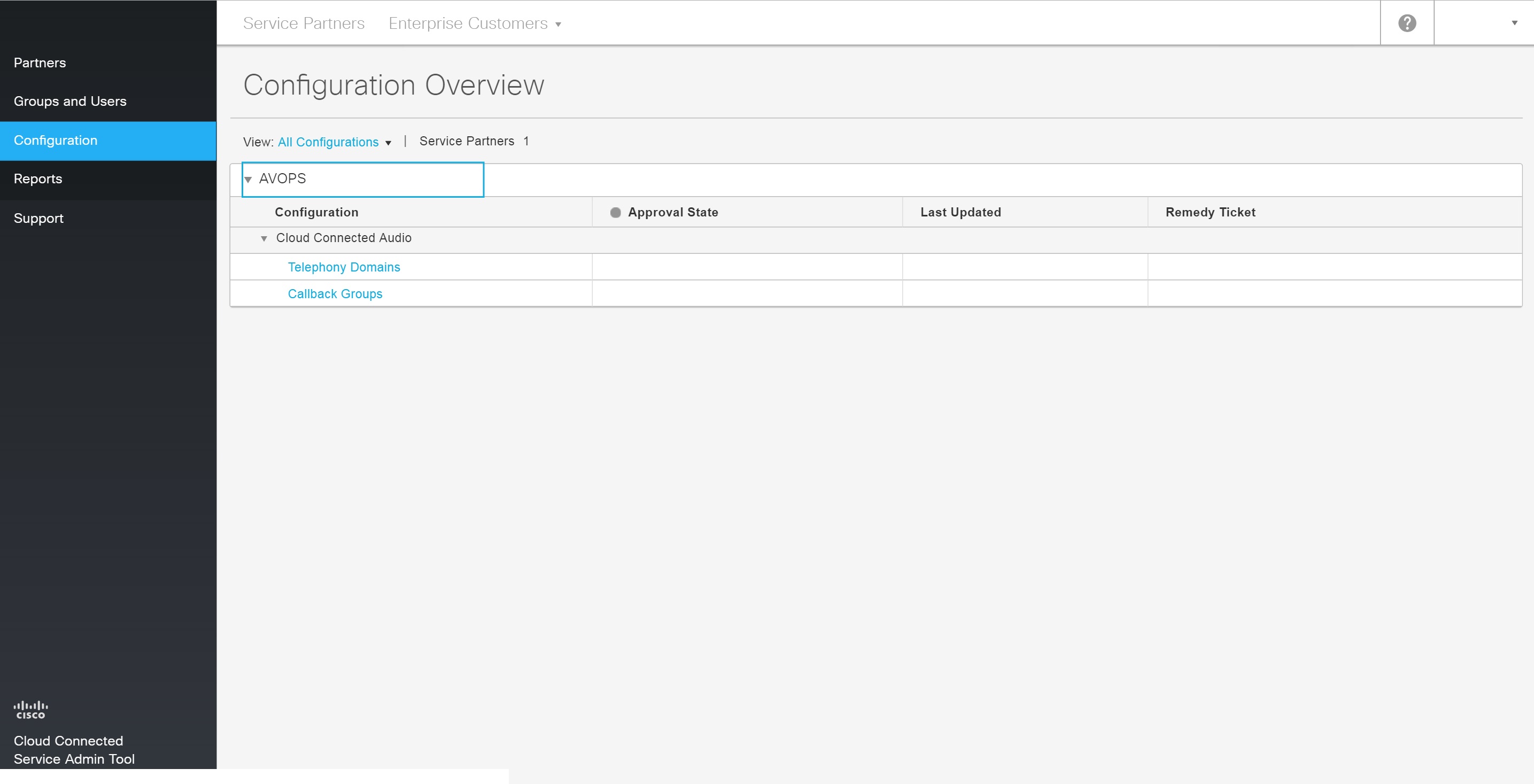- Home
- /
- Article

Manage Telephony Domains
 In this article
In this article Feedback?
Feedback?You, the Webex Cloud Connected Audio (Webex CCA) Service Provider Partner, can manage telephony domains from the Webex CCA Portal. Change requests made in the Webex CCA Portal are submitted to the Cisco Audio Video Operations (AVOPS) team.
Introduction
As a Webex Cloud Connected Audio (Webex CCA) service provider partner, you can use the Webex CCA Portal to manage, edit, and request additional telephony domains.
The following is a description of the relevant terms:
-
Telephony domain (TD) – Telephony domains define specific details for a unique partner or customer configuration and can be shared among sites on the same Webex cluster. Within the telephony domain, a phone number group set, Webex cluster, and audio bridge are assigned. There may be multiple telephony domains for a partner or customer if they have unique Webex sites on different bridges.
-
Webex site – A Webex site has a unique name and URL and its own database index. A Webex site is usually named after the company, and is the site that hosts company Webex meetings. Each site can have unique configurations that determine specific permissions, list of hosts, page branding, and telephony configuration.
-
Webex cluster – Each Webex site URL is linked to a specific cluster. A cluster is a group of servers in a pool that share a primary and a secondary location of service across different data centers.
-
Webex audio bridge – In the Webex CCA portal, a primary bridge and a backup bridge are tied together as a set. A Webex audio bridge can host a certain number of calls at one time and is assigned to a specific telephony domain. That specific telephony domain is assigned to a Webex site. Bridges can have unique configurations including multiple tenants and call-in and callback parameters.
-
Callback Group – A callback group defines which countries or regions can receive a callback from the system during a meeting.
View Telephony Domain Details
| 1 |
Sign in to the Webex CCA Portal, and go to Configuration. |
| 2 |
Choose your organization and select Telephony Domain. 
|
| 3 |
On the Telephony Domains page, select a domain to view a list of associated sites. |
Request a New Telephony Domain
| 1 |
Sign in to the Webex CCA Portal, and go to Configuration. |
| 2 |
Choose your organization and select Telephony Domain. |
| 3 |
Select Request Telephony Domain. If you aren’t CME certified for the region you selected, then you must enter a bridge name. If you’re CME certified in the region you selected, then you don’t need to enter a bridge name.
|
| 4 |
Then choose one of the following ways to add telephony numbers:
New telephony domain requests are rejected if:
|
| 5 |
Select Submit Request to submit the new telephony domain request. It takes five business days for new telephony domains to be approved and displayed in the Webex CCA Portal. |
Cancel or Edit a Submitted Telephony Domain Request
After making any submission to the Cisco AVOPS team, you can cancel or edit the submitted request. On resubmission, the five day approval process starts over.
Canceling a submitted telephony request only cancels the submission to Cisco. It does not delete the telephony request from the Webex CCA portal.
| 1 |
Sign in to the Webex CCA Portal, and go to Configuration. |
| 2 |
Choose your organization and select Telephony Domain. |
| 3 |
Select edit next to the submitted telephony domain submission that you want to edit. |
| 4 |
Select Cancel Submission next to the telephony domain submission. You can edit and resubmit telephony domain requests after you cancel them. You can't cancel submissions that have already been approved. |
Edit an Existing Telephony Domain
| 1 |
Sign in to the Webex CCA Portal, and go to Configuration. |
| 2 |
Choose your organization and select Telephony Domains. |
| 3 |
Select edit next to the telephony domain you want to edit. |
| 4 |
Make the necessary edits, select Submit Request, and then choose Submit. |
| 5 |
Choose Auto Sync, and then select Complete. |
Move a Site to Another Telephony Domain
| 1 |
Sign in to the Webex CCA Portal, and go to Configuration. |
| 2 |
Choose your organization and select Telephony Domain. |
| 3 |
Select the telephony domain that has the site that you want to move. |
| 4 |
Click the move site drop-down list and then choose the telephony domain you want to move the site to. Sites can only be moved to telephony domains on the same cluster. Sites can't be moved to different regions.
|
| 5 |
Select Yes. The move happens instantly after confirmation. If you want to move the site to a telephony domain within another telephony bridge, contact Cisco support or your account representative. |




